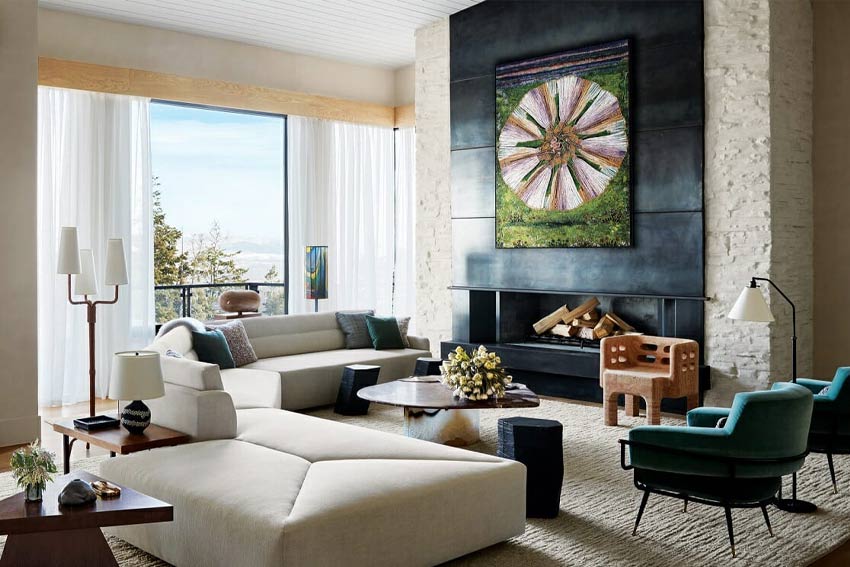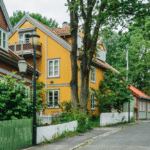As we move deeper into 2025, interior design continues to evolve—reshaping not only how our spaces look but how they work. The era of choosing between beauty and practicality is long gone. Today, the smartest design choices balance both: elegant form and everyday function.
Whether you’re redesigning your home, furnishing a new apartment, or just looking to make your space work harder for you, 2025’s design trends are all about purposeful style. Let’s dive into the top trends this year that marry aesthetic appeal with thoughtful utility.
1. Adaptive Color Palettes That Serve a Mood
Color sets the emotional tone of a room, and in 2025, designers are prioritizing palettes that support how we live and feel.
Warm neutrals, clay-based tones, muted greens, and oceanic blues are dominating spaces—not just for their visual appeal but because they enhance mental well-being and focus. These tones reflect nature and promote calm, making them ideal for both work-from-home nooks and stress-free living areas.
Plus, these adaptable hues blend seamlessly with natural light, which is crucial in creating a space that shifts comfortably from day to night.
2. Multi-Functional Furniture with a Luxe Edge
Space is a luxury, especially in urban living. That’s why multi-functional furniture continues to rise in popularity—but now with a more refined, design-forward approach.
Gone are the days of clunky fold-out beds and utilitarian pieces. Today, we’re seeing beautifully designed coffee tables that expand into dining tables, ottomans with hidden storage, and modular seating that adjusts to meet your needs.
A standout example is the rise in cleverly designed bunk bed solutions that combine sleeping, storage, and study areas into one seamless structure. In family homes or shared spaces, L-shaped bunk beds with integrated desks and drawers are solving the space issue without compromising on design. These pieces allow you to create organized, multi-purpose rooms that still feel open and uncluttered.
3. Seamless Smart Home Integration
Technology has become an inseparable part of our lives, but the best tech no longer shouts for attention—it blends into the background.
In 2025, smart home devices are being designed to disappear into the decor. From mirrors that double as touchscreens to hidden charging docks and automated blinds tucked behind wall panels, tech is becoming ambient, not disruptive.
Designers are opting for tech that complements aesthetics: under-counter lighting controlled by voice, wall-mounted thermostats with minimalist displays, and sound systems integrated into ceilings or baseboards. It’s all about convenience that doesn’t compromise your design vision.
4. Sustainable Materials That Do More
Environmental consciousness is no longer optional—it’s a priority. Homeowners and designers are turning to eco-friendly materials that are both stunning and sustainable.
Reclaimed wood, bamboo, recycled steel, and cork are being used in fresh, innovative ways. Think countertops made of recycled glass composites or floor tiles fashioned from compressed plastic waste. These materials not only look beautiful but also stand up to daily wear, making them a practical choice for families and pet owners.
Choosing these materials supports global sustainability goals while creating spaces that feel grounded, warm, and natural.
5. Modular Layouts for Multi-Use Spaces
As homes and offices become increasingly dynamic, modular design is meeting the demand for flexibility.
Instead of static room functions, people are opting for layouts and furniture that can adapt to various needs—whether it’s transforming a guest room into a home gym or a dining nook into a Zoom-ready office. Sliding partitions, collapsible furniture, and mobile shelving units are all in vogue for their space-maximizing potential.
Parents are also benefiting from these layouts, creating shared bedrooms or play zones that morph throughout the day. Even something as simple as choosing a lofted bed structure can open up the floor for a reading corner, play space, or workspace—proving that design and utility can coexist beautifully.
6. Statement Lighting That Serves a Purpose
Lighting isn’t just about visibility—it’s about mood, rhythm, and functionality. This year, layered lighting designs are taking over, with combinations of overhead fixtures, wall sconces, floor lamps, and smart LEDs working together.
Oversized pendant lights make bold statements in kitchens and entryways, while adjustable, dimmable task lights are becoming a standard feature in home offices and study areas. Many of these lights are designed with motion sensors or built-in USB ports, making them multitaskers in their own right.
As a bonus, energy-efficient lighting choices like smart bulbs also support sustainability goals by reducing your power consumption over time.
7. Biophilic Design That Supports Well-Being
Biophilic design—the art of bringing nature indoors—continues to thrive in 2025. But it’s not just about adding plants to a room.
Designers are strategically using natural textures like rattan, jute, linen, and raw wood to make homes feel connected to the outdoors. Large windows, skylights, and indoor gardens create visual and physical links to nature, which has been shown to reduce stress, enhance creativity, and improve cognitive function.
Elements like water features, moss walls, or even organically shaped furniture contribute to a sensory-rich environment that nourishes both body and mind.
8. Compact Tech Zones for Focused Use
As entertainment and work increasingly share the same space, people are carving out designated tech zones—compact areas optimized for function and style.
Gaming nooks, for example, are no longer afterthoughts. With the rise of sleek wall-mounted monitors, ergonomic chairs, and ambient lighting, these setups are becoming essential parts of the modern home. However, high use also means high maintenance.
It’s smart to stay ahead of wear-and-tear, especially with gaming equipment. Issues like joystick or controller drift are common, and rather than replacing an entire unit, many opt for practical services like stick drift repair for PS5 DualSense controllers to keep things running smoothly without waste.
This trend emphasizes the importance of making sure even our tech-heavy areas are designed to last and function well over time.
Final Thoughts: Form and Function Are No Longer Opposites
Interior design in 2025 is thoughtful, flexible, and deeply human. It recognizes that a beautiful space isn’t truly successful unless it also works for you—saving time, maximizing space, improving mood, and adapting to daily life.
Whether you’re furnishing a family home, upgrading your workspace, or reimagining your living room, let these trends guide you toward choices that balance elegance and everyday functionality. The future of design is not about choosing between style and use—it’s about blending both effortlessly.
So go ahead, reconfigure that spare room, upgrade to smart lighting, or invest in a piece that wears many hats. Your home will thank you—and so will your sanity.






